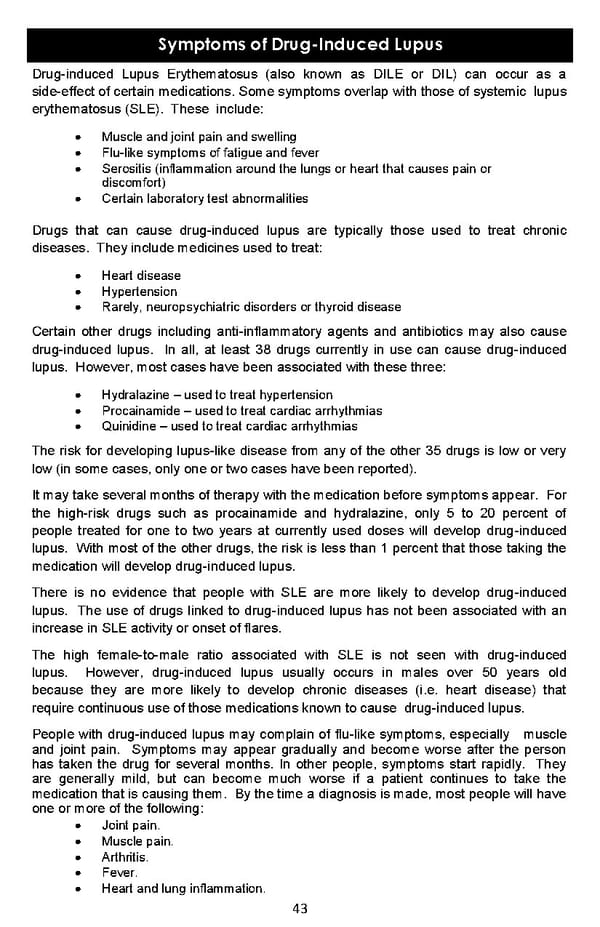Symptoms of Drug-Induced Lupus Drug-induced Lupus Erythematosus (also known as DILE or DIL) can occur as a side-effect of certain medications. Some symptoms overlap with those of systemic lupus erythematosus (SLE). These include: • Muscle and joint pain and swelling • Flu-like symptoms of fatigue and fever • Serositis (inflammation around the lungs or heart that causes pain or discomfort) • Certain laboratory test abnormalities Drugs that can cause drug-induced lupus are typically those used to treat chronic diseases. They include medicines used to treat: • Heart disease • Hypertension • Rarely, neuropsychiatric disorders or thyroid disease Certain other drugs including anti-inflammatory agents and antibiotics may also cause drug-induced lupus. In all, at least 38 drugs currently in use can cause drug-induced lupus. However, most cases have been associated with these three: • Hydralazine – used to treat hypertension • Procainamide – used to treat cardiac arrhythmias • Quinidine – used to treat cardiac arrhythmias The risk for developing lupus-like disease from any of the other 35 drugs is low or very low (in some cases, only one or two cases have been reported). It may take several months of therapy with the medication before symptoms appear. For the high-risk drugs such as procainamide and hydralazine, only 5 to 20 percent of people treated for one to two years at currently used doses will develop drug-induced lupus. With most of the other drugs, the risk is less than 1 percent that those taking the medication will develop drug-induced lupus. There is no evidence that people with SLE are more likely to develop drug-induced lupus. The use of drugs linked to drug-induced lupus has not been associated with an increase in SLE activity or onset of flares. The high female-to-male ratio associated with SLE is not seen with drug-induced lupus. However, drug-induced lupus usually occurs in males over 50 years old because they are more likely to develop chronic diseases (i.e. heart disease) that require continuous use of those medications known to cause drug-induced lupus. People with drug-induced lupus may complain of flu-like symptoms, especially muscle and joint pain. Symptoms may appear gradually and become worse after the person has taken the drug for several months. In other people, symptoms start rapidly. They are generally mild, but can become much worse if a patient continues to take the medication that is causing them. By the time a diagnosis is made, most people will have one or more of the following: • Joint pain. • Muscle pain. • Arthritis. • Fever. • Heart and lung inflammation. 43
 Living Well With Lupus Facts Booklet Page 42 Page 44
Living Well With Lupus Facts Booklet Page 42 Page 44